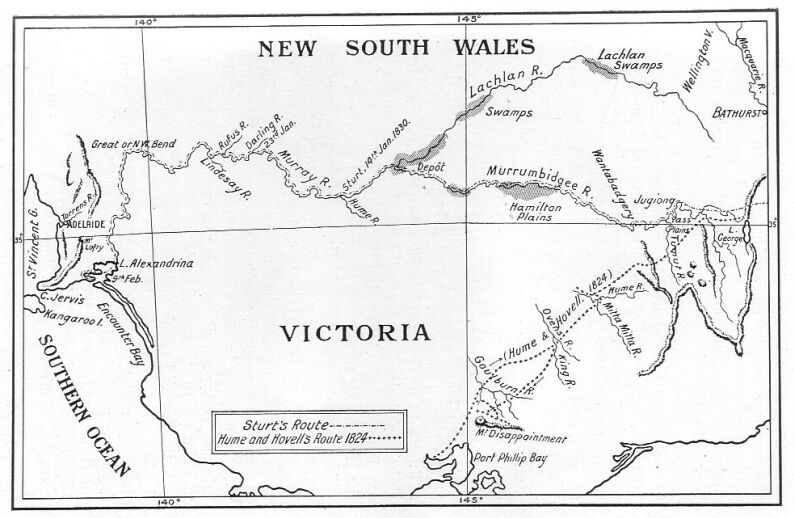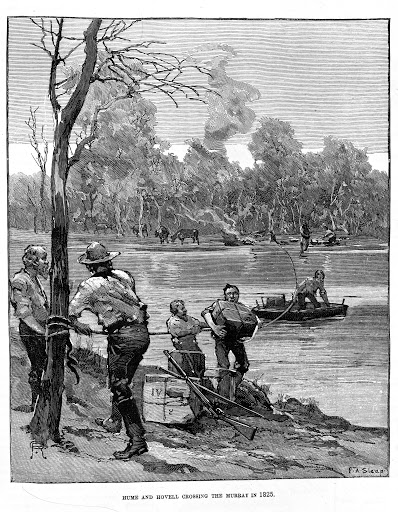In late 1824, Hamilton Hume and William Hovell led an expedition to find new grazing land for the colony. They and their party trekked south from Appin to Lake George, then down into Victoria, keeping west of the Great Dividing Range and ending up at Corio Bay, on the Victorian coast, where present day Geelong is situated. Hovell mistakenly believed they had arrived at Westernport, and did not realise his mistake until after his return. (1)

During their journey, they often followed native paths which they said showed impressions of the passage of a considerable number of natives, including women and children. Hume and Hovell also noted during their journey that the natives appeared to be numerous by the observance during the day of fires. It is likely the smoke of these fires were signals advising white men were coming. (1)
On Saturday, November 13th Hume and Hovell arrived at Friday Mount near Holbrook and on Sunday, November 14th arrived at Mulyan.yar Gunyah (eagles’ nest) or Table Top which they named Battery-mount. (1) (2)
They described the soil as excellent, rich red loam and the ground thinly wooded, and although parched the grass luxuriant and plentiful and of the best quality and noted, the natives, it would seem from their tracks, are numerous.
Close to the Murray River, they found many crescent-shaped lagoons and areas thickly wooded with large trees from which hung vines of various descriptions. Fern and peppermint, flax and currajong flourished.
The waterways abounded in codfish and bream of the finest possible flavour. The lagoons were crowded with wild ducks, and in the muddy bottom near the banks was plenty of large muscles which they said the natives dive for in the same manner as they procure the mud-oyster near Sydney. The native’s method of fishing was to select an outlet from a lagoon, which generally consists of a little stream of about two feet deep, and of about five or six feet broad. Across this, at no great distance from its junction with the river, they form a palisade with small stakes, which are driven firmly into the mud, and then carefully interwoven with wattles. Beyond this palisade, at the distance of five or six feet higher up the stream, they form a similar palisade, but leave an opening midway in its length, of about two feet wide. A dam being thus prepared, the natives go into the lagoon, where it is sufficiently shallow for their purpose, and beating the water with their wattles, and disturbing it in every possible way, drive the fish before them into the dam, which on being sufficiently full, is immediately closed, the fish, in consequence, falling an easy prize. (1)
Smoke, supposed to be that of the natives’ fires was constantly seen and the general appearance of the country, together with that of the soil they described as rich and beautiful. The grass having apparently been burnt early in the season and now in full seed was fresh and luxuriant, frequently as high as their heads, and seldom lower than their waists. Such reports as this ignited interest in overlanders to head into the Port Phillip district.
November 17th Hume and Hovell camped beside the Hume River later renamed the Murray on the spot where 14 years later Robert Brown would open a store and inn. Hovell marked the occasion by carving his name and date on a tree.
Hume and Hovell crossed the river on November 22nd and entered Merriman’s Waywurru lands and here they found the grasses equally fine and the wild flax, both in height and luxuriance, far superior. They noted that many of the trees bore the marks of iron tomahawks.
The Waywurru people would have known Hume and Hovell were entering their lands from the smoke signals Hume and Hovell constantly saw. It is possible runners who spoke some English also followed to report on the activities of the white men.
We know indigenous people kept an eye on white men’s activities in their country from a report by William Thomas, Aboriginal protectorate who wrote on 29th Dec 1847, ‘To the despair of the missionary teachers, the children always followed the directions of the old men regarding perambulations about the country. Although one boy was always left at the school to spy on European activities.’ Lady Jane Franklin wrote similarly in her journal in April 1839 when she spoke to a policeman on The Broken River. This man told her he, ‘ was sure they had seen us the whole way.’ (3)
Once Hume and Hovell had crossed the Murray River they were on Waywurru land. It is interesting to note they recognised cut marks on the trunks of trees that had been made using an iron tomahawk. It begs the question – how did the iron tomahawk come to be this far away from white settlements?
On Wednesday, November 24 Hume and Hovell crossed the Oven’s river with ease as the water was now low. They described it as having the usual series of lagoon, swamp, and creek and said the banks and all the neighbouring country, which is extremely beautiful, consists of the finest possible soil. It being scantily wooded but with timber trees of the most valuable description. (1)
At times Hume and Hovell had difficulty feeding their horses and oxen as the country in their line of route had been burned. They arrived at the Oxley Plains and described it as, ‘of fresh pasturage, interspersed here and there with small plains or meadows.’ (1)
Hume and Hovell concluded the natives hereabouts were numerous, ‘as from their fires, the smoke of which is observed in every direction. Yesterday their voices were distinctly heard, but none of them could be seen.’ (1)
On Sunday 28th November they climbed ‘Sunday Mount’, thinking it was the hill immediately north of Samaria, overlooking Dodd’s Crossing at Fern Hills, South of Tatong. They then crossed Samaria Creek and camped by the Broken River, which they called the ‘Swampy’, and the land about it ‘Norton’s Meadows’ (1)
On Dec 2nd, Hume and Hovell noted the natives have again fired the grass in their advance.
On Dec 17th, Hume and Hovell arrived at Imaroo or Geelong and made comment on the numerous fires which were being made around them remarking they were signals among the natives. They spent three days resting before retracing their steps back the way they came and by Dec 22nd were at Sunday Creek at Tallarook.
On Dec 31st they camped on the banks of the Ovens River and on January 2nd 1825 they arrived at the Murray River where they surprised about thirty native women and children.
‘The children were engaged in play, throwing small spears, formed of reeds, at a circular piece of bark, about a foot in diameter, while it was rolling along the ground; and the women were employed in spinning the native flax, one of whom gave notice of their approach, crying out white man! white man! minija! minija! which in the language of the natives of the Murrumbidgee, would imply “make haste, make haste,” and in a few minutes disappeared.’ (1)
The game described closely resembles JFH Mitchell’s ‘currum-barlee’ spear throw competition where the wooden disk was hurled down an embankment.
Merriman would have been two years old at the time Hume and Hovell made their appearance on the Murray River. If he had been present at the sudden appearance of the white men his mother would have fled into the bush carrying him on her shoulders, his little legs either side her neck, his small fingers tightly curled in her hair.
During Hume and Hovell’s expedition, they had constantly been under watch by indigenous people who sent fires and smoke signals to advise of their position. So why was it possible for these women and children to be unaware of Hume and Hovell’s approach?
The date was January 2nd and at high summer much of the indigenous population was still in the high country enjoying the cooler climate. Women with small children, the elderly and the infirm would have found it difficult to traverse that steep and rugged country so perhaps this group of women and children had stayed behind at the semi-permanent camp at Mungabareena.
Hume and Hovell crossed the Murray River which was now low and easily fordable, the waters not exceeding three or four feet in depth. (1)
They took a few days to rest on the grassy river banks, eating well of abundant fish and waterfowl. On Thursday, January 6th in the vicinity of Mulyan-gunyah or Table Top, Hume and Hovell were approached by natives who made marks of friendship. One of these men was dressed in an old yellow jacket, spoke a few words of English, and had been at Lake George. They had among them, one iron axe, and four tomahawks. These natives stayed with them till dark and promised to return in the morning. (1)
Friday 7th January, forty able-bodied men, all armed arrived at the white men’s camp. Their spears were made of strong knotted reeds, about six feet long, to which was affixed a piece of hardwood, about two feet in length, with a rounded point, barbed in some instances, with numerous small pieces of flint or agate. (1)
Because the horses had strayed during the night two of the natives were employed a considerable part of the morning in tracking and bringing them in. The natives then begged the explorers to accompany them to their camp, about a mile further on so that the women and children might have an opportunity of seeing them. Mr Hume, taking three of the men with him, complied with their request. He met with a party of about thirty women, as many children, and some fine young men. They invited him to remain with them as they were going to have a “Corrobera,” two of them promising, in event of his compliance, to accompany him and his party, the following day as far as the Murrumbidgee. (1)
The men were the finest natives Hume and Hovell had ever seen. they wrote, ‘one of them about six feet high, and another whom they measured, five feet, nine inches and a half.–They were all robust and well proportioned.’ (1)
Each of these people was furnished with a good ample cloak of opossum skin, many of them had necklaces, made of small pieces of a yellow reed strung with the fibre of the currajong, the flax-plant, or the hair of the opossum. (1)
It is interesting to note that even though it was high summer all the people had their possum skin cloaks with them.
source;
(1) Journey of Discovery to Port Phillip by William H Hovell and Hamilton Hume
(2) Friday Mount, Margaret Carnegie
(3)This Errant Lady, Lady Jane Franklin, diary pg 53. Monday 15th April 1839.
(4) GA Robinson, journal, 1839-52.


